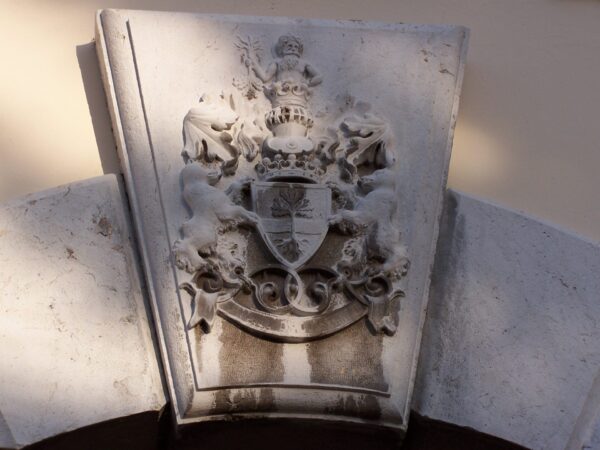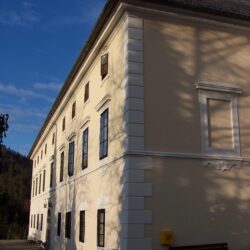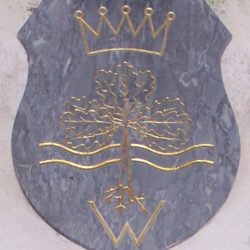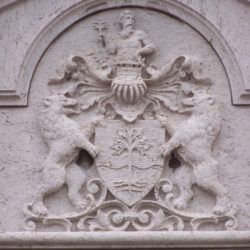
Coat of arms of the Barons Wurzbach-Tannenberg in Črni Potok Mansion
ČRNI POTOK, MANSION
Location of the coat of arms: portal
Despite their German roots, originating in the Principality of Reuss between Bavaria and Saxony, the Wurzbachs may be regarded as an old Carniolan family. Already before their arrival in Carniola, their ancestors are believed to have had a noble title and a coat of arms that their descendants continued to use even after being granted a new one in 1854.
The founder of the Carniolan line of Wurzbachs was Maximilian (1781–1854), who received his doctorate in law in Ljubljana in 1806 and opened a law firm. His wife, Josefa Pinter, the daughter of a Ljubljana-based gingerbread maker and confectioner from the Šentjakob suburbs, bore him ten sons, which led to substantial ramification of the family. The most notable were the oldest, Karl, who become Carniola’s provincial governor and provincial president, and the seventh-born Konstantin, the famous lexicographer and biographer, whose monumental work Biographisches Lexikon des Kaiserthums Oesterreich (Biographical Encyclopedia of the Austrian Empire) was published in sixty volumes.
A distinguishing feature of the Wurzbach family is that three of its members were conferred three consecutive noble ranks, which is very rare in practice. The father Maximilian was raised to nobility with the honorary title Edler in 1854, followed by the oldest son Karl, who was granted the baronial title in 1872, and the seventh-born son Konstantin, who obtained the knightly title two years afterward. The coat of arms that the Wurzbachs presumably brought with them from their homeland had a rather simple design, and it was an example of canting arms, corresponding to the etymology of the family’s name—the escutcheon featured an uprooted oak tree with its roots (Germ. Wurzel) and a stream (Germ. Bach). The same design was used for the baronial coat of arms, to which was added the motto SINCERE ET CONSTANTER ‘sincere and constant’. On the other hand, both the knightly and noble escutcheons are divided into four fields, differing only in that the former features two helmets and the latter only one. Both display the same motto as the baronial coat of arms.
The Wurzbachs were the castellans of a considerable number of castles, manors, and mansions across Carniola, including Groblje at Rodica near Domžale, Črni Potok (Schwarzenbach) and nearby Sela as well as Grič near Primskovo, and subsequently also Lanšprež (Landspreis) near Mirna, Moravče, Češnjice, and Preddvor.
A depiction of the Wurzbach coat of arms can be found above the entrance to Črni Potok Mansion, currently housing a home for the elderly. It is a baronial coat of arms (wrongly attributed in the literature to the Barons Apfaltrer), representing Baron Karl von Wurzbach (1809–1886), who owned the mansion in the mid-nineteenth century, and then his son Alfons (1853–1939) after the mansion was passed on to him.
Sources:
Prhavc Šipič, Nevenka: O tebi šepetam, Litija: zgodba sester pl. Wurzbach. In: Kronika 59, 2011, št. 3 (Iz zgodovine Litije in okolice), pp. 639-670.
Rugále, Mariano & Preinfalk, Miha: Blagoslovljeni in prekleti. 1. del: Plemiške rodbine 19. in 20. stoletja na Slovenskem. Ljubljana: Viharnik, 2009, pp. 203–216.
Stopar, Ivan: Grajske stavbe v osrednji Sloveniji. 2, Dolenjska. 2. knjiga: Med Bogenšperkom in Mokricami. Ljubljana, Viharnik, 2001, p. 39.



